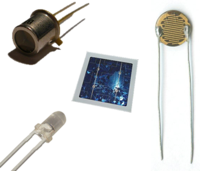
Photo from wikipedia
In this paper, quaternary oxide semiconductor was applied as sensing material for the fabrication of gas sensors. One-step solvothermal method was utilized to synthesize the sensing material. Various characterization methods… Click to show full abstract
In this paper, quaternary oxide semiconductor was applied as sensing material for the fabrication of gas sensors. One-step solvothermal method was utilized to synthesize the sensing material. Various characterization methods including XRD, XPS, SEM, HRTEM were employed to analyze the composition and structure of the sensing material. Composite composed of CuInW2O8 and CuWO4 was successfully prepared at last characterized by XRD result. The SEM result revealed the structure of the sensing material: nanoparticles assembled spindle-like nanostructure with ~200 nm long axis and ~60 nm short axis. Sensor based on the spindle-like nanostructures was systemically tested to acquire the information about the sensing properties. The sensor exhibited responses to acetone at the operating temperatures from 190 to 275 °C. The results showed that the sensor was more sensitive to acetone compared with other gases at the optimal operating temperature of 210 °C. The response of the sensor was also tested under the relative humidity from 25 RH% to 95 RH% at the operating temperature of 210 °C. The response variation was only 13.9%, demonstrating that the sensor possessed strong anti-humidity ability. It was worth noting that the sensor showed acceptable long-term stability compared with other acetone sensors. The gas sensing mechanism was also discussed here. This work might provide ideas for the development of novel sensitive materials for the application of gas sensors.
Journal Title: Journal of colloid and interface science
Year Published: 2021
Link to full text (if available)
Share on Social Media: Sign Up to like & get
recommendations!